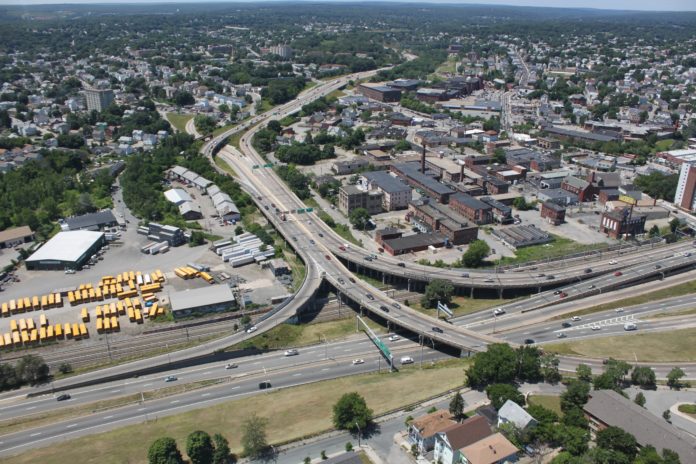
The Pawtucket River Bridge is illuminated, the Sakonnet River Bridge is tolled, and the Providence Viaduct is under construction.
But there’s another Rhode Island bridge, or set of bridges, that needs work and could cost taxpayers more than any of them to fix: the Route 6/Route 10 interchange in Providence.
At an estimated cost of up to $500 million, it is the most expensive unfunded highway construction project on the state’s to-do list and could be one of the toughest to find the resources for.
“The state has been working on reconstruction of the interchange for many years and it has always been put off for lack of available funds,” said R.I. Department of Transportation Director Michael Lewis. “Our ability to go ahead now is contingent on a financing plan for the whole state. We are putting together a better bridge program.”
In ongoing General Assembly discussions about finding the best way to pay for transportation infrastructure, the Route 6/Route 10 interchange looms over the debate.
Repairing it is expected to cost more than twice as much as the new Sakonnet bridge, where local outrage over tolls nearly brought down the state budget last year and triggered the creation of the special commission studying transportation funding.
Few argue that the state needs to do something about the interchange, with its cracking concrete and rusted rebar.
The U.S. Department of Transportation has said it doesn’t want good money thrown after bad and won’t allow more federal highway dollars to be used for temporary repairs to the structure.
That means the state will have to spend more of its own funds to make the repairs needed to keep the highways open.
Over the last five years, the state has spent $14.6 million on three projects along the Route 6/Route 10 connector in Providence, including $8 million for the replacement of the Union Avenue Bridge, $1.8 million to shore up the Huntington Viaduct Bridge, and $4.8 million for the removal of the Magnolia Bridge.
Lewis said adding $40 million to the state’s annual investment in bridges over the next 10 years could bring the system into good repair.
But none of that would include work on the 6-10 interchange and it’s unclear where any of it would come from with the state facing a $100 million budget gap for fiscal 2015.
So what can the state do about the interchange while managing so many other deficient structures?
Lewis thinks there are creative ways to bring the cost of replacing the interchange below the $481 million estimated in 2005 by limiting the scope of work within available funding and using “unique procurement and design-build” strategies.
Comprised of 11 separate bridges all rated structurally deficient, the interchange merges Route 6 to the west and Route 10 to the south into the 6-10 connector to downtown Providence.
The oldest parts of the interchange opened in 1953 as a bypass around the bustling Olneyville neighborhood and those older parts of the system are the ones that need to be replaced.
Now an uneven web of ramps and overpasses straddling Olneyville and the Northeast Corridor rail lines, the interchange is one of many mid-20th-century, elevated urban expressways throughout the country nearing the end of its life.
As Rhode Island did with the relocation of Interstate 195, many states and cities have considered burying, moving or replacing their old highways with ground-level streets as alternatives to rebuilding them as they are.
Indeed, the connector’s eastern end is routinely jammed at the Dean Street exit ramps and again one-third of a mile away at its intersection with Interstate 95.
Asked about the possibility of not rebuilding the interchange or replacing sections of the expressway with surface-level roads, Lewis said elimination was “not workable.”
“It’s just too much a part of the transportation system” to eliminate, Lewis said. “I don’t think there is a transit option that would take care of this need. If [routes] 6 or 10 access was not available, all that traffic would have to go somewhere else and shift to [Interstate 95] and local roads.”
According to RIDOT figures, the connector system is most heavily used by drivers from the south as an I-95 bypass. An average of 90,000 vehicles per day use Route 10 south of the interchange, 56,000 vehicles use Route 6 west of the interchange and 102,000 use the connector into downtown.
In addition to concerns about diverting traffic onto other already congested roads, Lewis said the fact that the interchange crosses the northeast corridor train tracks means some sort of bridge or tunnel would need to be built to get even a local road across the rails.
John Flaherty, research and communication director at GrowSmart Rhode Island, said while the fiscal impact of replacing the interchange is daunting, he can’t see a way around doing the work at this point.
“Obviously we are supporting mass transit, but we recognize in transit we need sound bridges and roads for buses to travel,” Flaherty said. “As far as design alternatives, this pretty much connects Providence to the western part of the state, so if you just put all those cars on I-95, that would create significant bottlenecks.” •












